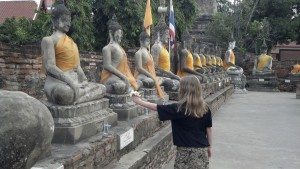 I’m writing from an old, wooden Thai guesthouse with a peaked roof and a romantic white mosquito net hanging over the bed. We’ve just enjoyed two glorious weeks in Thailand with our daughters, returning to a country we love after about 18 years away. There’s been an enormous influx of tourism since we left. Where we were once the only westerners on islands full of mangroves and Thai villages, there are now fancy resorts and throngs, yes throngs, of tourists from all over the world. These tips are for you as a traveling family to help you enjoy Thailand. They are also aimed at educating traveling families about how they can contribute to protecting the country and the culture as they explore. There’s so much to enjoy for families in Thailand and the more you know in advance, the better travelers you can be. What do you need to know to make a trip to Thailand with kids successful? Here are a few questions you might be asking …
I’m writing from an old, wooden Thai guesthouse with a peaked roof and a romantic white mosquito net hanging over the bed. We’ve just enjoyed two glorious weeks in Thailand with our daughters, returning to a country we love after about 18 years away. There’s been an enormous influx of tourism since we left. Where we were once the only westerners on islands full of mangroves and Thai villages, there are now fancy resorts and throngs, yes throngs, of tourists from all over the world. These tips are for you as a traveling family to help you enjoy Thailand. They are also aimed at educating traveling families about how they can contribute to protecting the country and the culture as they explore. There’s so much to enjoy for families in Thailand and the more you know in advance, the better travelers you can be. What do you need to know to make a trip to Thailand with kids successful? Here are a few questions you might be asking …
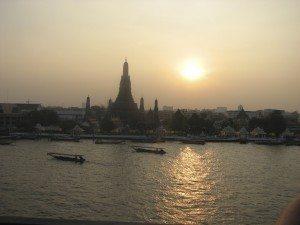 What to bring? As little as possible is the best rule of thumb. Getting laundry done is pretty easy and rarely expensive; carrying heavy bags is hot and frustrating. Remember to bring a hat and sunscreen. Lip balm with super sunscreen is nice to have and can double as protection for ears or nose in a pinch. It’s not a bad idea to have a small, collapsible umbrella to keep your kids in the shade. You can buy cheap umbrellas for a few dollars once you’re in Thailand. You can buy expensive, small, light, and sturdy ones at adventure or outdoor stores at home. Bring a range of anti-mosquito products. We found some smelly plastic bands at an adventure sport store that could be worn as anklets. These helped tremendously. We also brought DEET and eucalyptus-based products. Our best travel gadgets this trip were, unexpectedly, swimshirts! We brought long-sleeved, UV protective swim shirts for each girl and wished we had thought to buy them for ourselves as well.
What to bring? As little as possible is the best rule of thumb. Getting laundry done is pretty easy and rarely expensive; carrying heavy bags is hot and frustrating. Remember to bring a hat and sunscreen. Lip balm with super sunscreen is nice to have and can double as protection for ears or nose in a pinch. It’s not a bad idea to have a small, collapsible umbrella to keep your kids in the shade. You can buy cheap umbrellas for a few dollars once you’re in Thailand. You can buy expensive, small, light, and sturdy ones at adventure or outdoor stores at home. Bring a range of anti-mosquito products. We found some smelly plastic bands at an adventure sport store that could be worn as anklets. These helped tremendously. We also brought DEET and eucalyptus-based products. Our best travel gadgets this trip were, unexpectedly, swimshirts! We brought long-sleeved, UV protective swim shirts for each girl and wished we had thought to buy them for ourselves as well.
What to wear? Thailand is a modest country with peaceful Buddhist temples to the North and inland as well as spectacular Muslim villages along the Southern Coast. Look around. There are few Thai people in short shorts or tank tops. You will be more respectful and even cooler if you choose skirts or light pants – long shorts and short pants are both fine. T-shirts are OK but long-sleeved, light cotton blouses feel cooler, don’t show sweat, and protect your skin from the sun. Young kids can wear shorts but modesty is still appreciated.
What sort of shoes should I bring? For me, shoes that don’t make my back hurt even when I am carry heavy bags or children are essential. They shouldn’t hurt my feet either – even when I am carrying nothing. I don’t want them to require socks, that’s for sure, and it’s a bonus if they don’t stink when they are hot and sweaty. The really difficult part is that, in Thailand, it’s also very handy if your shoes come on and off easily. You’ll need to slip them on and off visiting temples, friend’s houses, and even moving between your hotel room and bathroom at times. I do not have the perfect solution. This last trip I compromised by bringing Keen sandals (light, don’t hurt back or feet, not too stinky, a little ugly, hard to get on and off) for walking and traveling days as well as a pair of thick, sparkly flip-flops (even lighter, significantly more attractive with skirts, easy on and off, not stinky at all, cool, but completely lacking in arch or back support) for visiting and short-walk days as well as fancy dinner out. Yes, sparkly flip-flops can count as fancy dinner shoes in the right social circles.
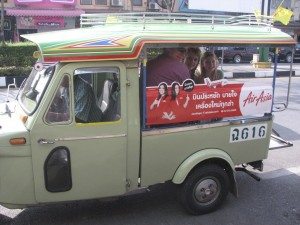 Stroller or backpack? I’ve never tried pushing a stroller down a Thai street but I think it would be a tremendous challenge. As well, moving through traffic is difficult. A backpack with shade for small kids will be hot but generally easier and safer. The same idea applies to luggage. Wheels simply aren’t particularly helpful except in the airport or the shopping mall.
Stroller or backpack? I’ve never tried pushing a stroller down a Thai street but I think it would be a tremendous challenge. As well, moving through traffic is difficult. A backpack with shade for small kids will be hot but generally easier and safer. The same idea applies to luggage. Wheels simply aren’t particularly helpful except in the airport or the shopping mall.
Train or plane? We were disappointed to see that Thai Airways no longer flies to a few of our favorite cities. However, we then learned that discount airlines are popping up to provide inexpensive shuttles within Thailand. We didn’t discover these airlines until after arriving in Thailand because they don’t pop up on many popular search engines. We went by train. First class tickets were about $100 per person round trip from Bangkok to nearly the border with Malaysia. Each first class cabin is air-conditioned and has a sink, but holds only two people. Wonderfully, they have adjoining rooms – perfect for traveling families! During high season, you will need to book tickets as soon as they go on sale, 60 days in advance.
What to eat? Fruit that can be peeled. We managed 16 or 17 different types of Thai fruit in 14 days this trip and many other species were out of season. This might be a world record. To be fair, we had help from Thai friends set on us expanding our children’s fruit horizons. I would especially like to recommend Thai bananas. Some look like American bananas but they taste 1,000 times better. As a Thai friend told us 18 years ago, “Once you taste Thai banana, you never eat American banana again.” Don’t forget the shorter varieties, the tiny varieties, and the red ones too! You can also find plain white rice everywhere and I would be shocked if any Thai restaurant frowned on you for bringing in a small yogurt, bag of chips, or fruit snack to help your child navigate the new foods.
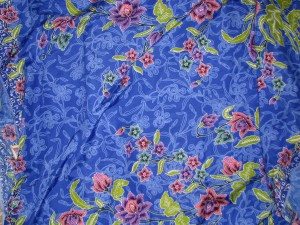 What is a sarong? A sarong in a pretty length of fabric, usually sewn into a tube, and traditionally worn by Thai villagers. There are flowered patterns for girls or women, plaids for boys or men. It is a brilliant invention and a good investment when traveling with kids in Thailand. You can buy sarongs easily at most local markets for a few dollars. Wear the sarong as a skirt, sleep in it like a sheet, hold it up for shade, use it for a towel, or lay it down to create a clean place for small kids to play. I’m sure you can also rig one as a baby sling but I personally haven’t tried it.
What is a sarong? A sarong in a pretty length of fabric, usually sewn into a tube, and traditionally worn by Thai villagers. There are flowered patterns for girls or women, plaids for boys or men. It is a brilliant invention and a good investment when traveling with kids in Thailand. You can buy sarongs easily at most local markets for a few dollars. Wear the sarong as a skirt, sleep in it like a sheet, hold it up for shade, use it for a towel, or lay it down to create a clean place for small kids to play. I’m sure you can also rig one as a baby sling but I personally haven’t tried it.
What to say? I think the most important word in the Thai language is arroy or ah–ROY (emphasis on the second syllable). It means “delicious!” Everyone wants to know that you enjoy the food and if you can tell them in Thai, even better. Small kids who enjoy their meal and respond with arroy will be welcome anywhere.
What not to eat? Food on the train. When I lived in Thailand 18 or so years ago, vendors would hop aboard the train and sell delicious snacks. This time, I was offered a menu from an official employee of the “Bogie Restaurant” (yes, it was really called that – I think it is the dinner car). We tried ordering one breakfast going South – mai arroy (not delicious)! In fact I would give it a “double yuck” rating. We foolishly tried again on the way North by augmenting our dinner snacks with two set meals. I think this is what hospital food tasted like in the late 1950s.
The other thing to be very wary of is “sausage.” Somehow the concept of “blucky hot dog with the ends cut into a decorative little pattern” has been mis-translated as “sausage.” For breakfast, you may be surprised to find yourself with a plate of fried eggs and julienned hot dogs. Fried rice with hot dog? Hot dog on a stick? Of course, your toddler may be thrilled! (To avoid confusion, ask if the sausage is Thai versus American.)
How to plan your day? It’s hot! The best times for going out and about are in the early morning and the late afternoon. If you’ve traveled in Europe, you might be tempted to imagine pleasant days wandering between sights. Nope. Walking is hot, sidewalks are unpredictable, and crossing streets is difficult. Find safe transportation and plan your activities to coincide with the coolest times of the day.
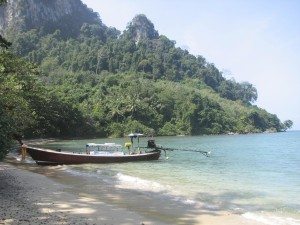 What about my bikini and my beer on the beach? OK, OK, OK. I just have to say this again. Thailand is a modest and beautiful country. Many coastal villages are Muslim. If you or your teen want to wear a speedo or a string bikini inside your resort, that’s your decision. If you want to wander in the village browsing shops or sipping a cold drink in a restaurant, please respect the local customs. Cover your shoulders, cover your legs from the knees up, and drink beer where it’s served – not walking down the street. The whole village is not a western resort even if the village economy depends on your tourist dollars.
What about my bikini and my beer on the beach? OK, OK, OK. I just have to say this again. Thailand is a modest and beautiful country. Many coastal villages are Muslim. If you or your teen want to wear a speedo or a string bikini inside your resort, that’s your decision. If you want to wander in the village browsing shops or sipping a cold drink in a restaurant, please respect the local customs. Cover your shoulders, cover your legs from the knees up, and drink beer where it’s served – not walking down the street. The whole village is not a western resort even if the village economy depends on your tourist dollars.
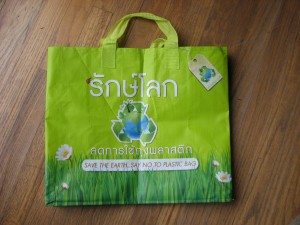
What could we do to set a good example? It’s easy to set a bad example as a tourist and it can be pretty funny to make fun of those stereotypes. It’s harder to imagine how tourists can set a good example. One idea is to refuse plastic bags. Thailand is overflowing in plastic bags. Bags fill gutters, cling to trees, and clog beaches. When packing our souvenirs, we found that our family of four had unnecessarily accumulated dozens and dozens of plastic bags in all sizes. And, that was even after we started saying no to extra bags. Why not be a trendsetting family and bring or buy a nice re-usable bag? You can easily use hand language to indicate that you don’t need a bag. Shopkeepers will appreciate your frugality and you’ll find yourself with less garbage in your pockets at the end of the day too. Maybe if all the tourists start refusing plastic bags, the locals will follow suit.
What to watch out for? Crossing streets is an art in Thailand. Motorcycles weave in and out of trucks, buses, cars, and tuk-tuks. They expect pedestrians to behave in particular Thai ways and they drive accordingly. Look both ways, hold hands, and stay alert. There are also the usual issues of pick-pockets in touristy locations. And sun and mosquito management will be part of your daily routine.
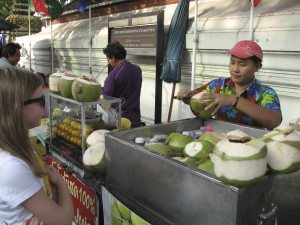 Specialty items for the dayback? Toilet paper! Do not leave home without it. This is generally a BYOTP country. Remind your kids not to throw toilet paper into a Thai toilet. The plumbing isn’t ready. It’s also great to have hand sanitizer and sunscreen at the ready. Bug repellant to prevent tomorrow’s mosquito bites and anti-itch medication for yesterday’s. A little umbrella for instant shade is a good idea. I usually carry money in two wallets. One with big bills, credit cards, and ID is kept securely in a hard to access location. Another has quick cash for urgent needs like a fresh coconut or bag of kanom (a brilliant word which means “pretty much any sweet delicious little thing”).
Specialty items for the dayback? Toilet paper! Do not leave home without it. This is generally a BYOTP country. Remind your kids not to throw toilet paper into a Thai toilet. The plumbing isn’t ready. It’s also great to have hand sanitizer and sunscreen at the ready. Bug repellant to prevent tomorrow’s mosquito bites and anti-itch medication for yesterday’s. A little umbrella for instant shade is a good idea. I usually carry money in two wallets. One with big bills, credit cards, and ID is kept securely in a hard to access location. Another has quick cash for urgent needs like a fresh coconut or bag of kanom (a brilliant word which means “pretty much any sweet delicious little thing”).
Thailand is more than beaches and golden Buddhas. Bring your children. Teach them to speak a few words. Help them to discover and respect the traditions, the landscapes, and the religions on which Thailand was built.
P.S. For more tips on traveling in Asia with kids see Taipei with Kids: 24 Tips for a Great Trip that we wrote for WanderingEducators.com

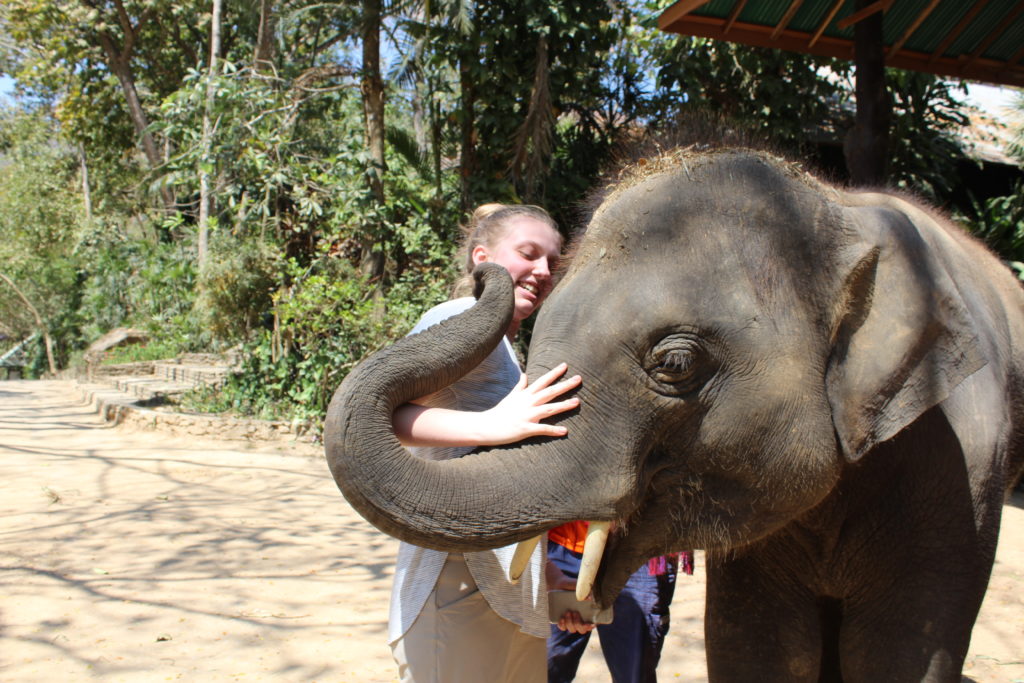
What a great list of travel tips – for ANYONE headed to Thailand!